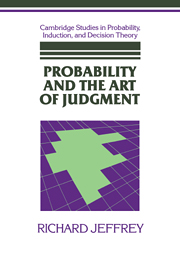Book contents
- Frontmatter
- Contents
- Preface
- 1 Introduction: Radical probabilism (1991)
- 2 Valuation and acceptance of scientific hypotheses (1956)
- 3 Probable knowledge (1968)
- 4 Probability and the art of judgment (1985)
- 5 Bayesianism with a human face (1983)
- 6 Alias Smith and Jones: The testimony of the senses (1987)
- 7 Conditioning, kinematics, and exchangeability (1988)
- 8 Preference among preferences (1974)
- 9 On interpersonal utility theory (1971)
- 10 Remarks on interpersonal utility theory (1974)
- 11 Mises redux (1977)
- 12 Statistical explanation vs. statistical inference (1969)
- 13 New foundations for Bayesian decision theory (1965)
- 14 Frameworks for preference (1974)
- 15 Axiomatizing the logic of decision (1978)
- 16 A note on the kinematics of preference (1977)
15 - Axiomatizing the logic of decision (1978)
Published online by Cambridge University Press: 05 June 2012
- Frontmatter
- Contents
- Preface
- 1 Introduction: Radical probabilism (1991)
- 2 Valuation and acceptance of scientific hypotheses (1956)
- 3 Probable knowledge (1968)
- 4 Probability and the art of judgment (1985)
- 5 Bayesianism with a human face (1983)
- 6 Alias Smith and Jones: The testimony of the senses (1987)
- 7 Conditioning, kinematics, and exchangeability (1988)
- 8 Preference among preferences (1974)
- 9 On interpersonal utility theory (1971)
- 10 Remarks on interpersonal utility theory (1974)
- 11 Mises redux (1977)
- 12 Statistical explanation vs. statistical inference (1969)
- 13 New foundations for Bayesian decision theory (1965)
- 14 Frameworks for preference (1974)
- 15 Axiomatizing the logic of decision (1978)
- 16 A note on the kinematics of preference (1977)
Summary
Ethan Bolker's theorem [1, 2] on the representation of functions resembling quotients of measures underlies the logic of decision [5] in the same way in which Hölder-like theorems on the representation of Archimedean ordered groups, semigroups, etc., are seen in [6] as underlying various foundational systems of measurement. In [3] and in chapter 9 of [1] Bolker applies his theorem to a system akin to that of [5], proving existence and uniqueness of probability and utility functions for preference rankings that satisfy certain axioms. Here I want to clarify the framework of [5] and bring Bolker's theorem to bear directly upon it. It should be noted that Bolker's theorem predated [5] and made it possible.
The logic of decision can be viewed as a theory with a binary relation term (“nonpreference”) as its only primitive (apart from the notation of set theory or, alternatively, of higher-order logic). A model of the theory is a pair (u, P) where P is a probability measure on a σ – field M of “events” (measurable sets) and u is an integrable function on the union, W, of M. A sentence of the theory is valid in a model iff true for all assignments to its free variables of sets in M, when for E ∈ M we define U(E) as the conditional expected utility.
- Type
- Chapter
- Information
- Probability and the Art of Judgment , pp. 232 - 237Publisher: Cambridge University PressPrint publication year: 1992



